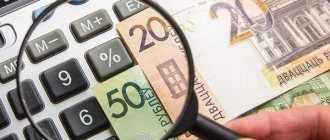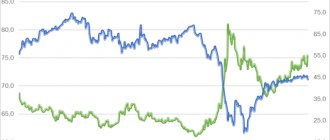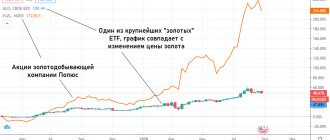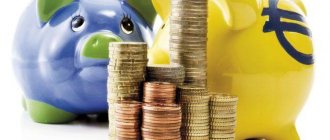Hello, dear readers of the Tyulyagin project! In today's article we will talk about what is devaluation. With the development of a market economy and the transition of national currencies to market rates, this economic term is heard even by those people who are far from economics. In this article I will try to explain what devaluation is in simple language that is accessible to everyone. I will analyze in detail the causes and consequences of the devaluation of national currencies, including the devaluation of the Russian ruble. I’ll also tell you what to do with savings during currency devaluation.
Devaluation - what does this word mean?
Devaluation is a decrease in the exchange rate of the currency of one state in relation to the currencies of other countries, usually reserve currencies (dollar, euro, pound, yen, etc.). As you can see, the concept itself is simple and easy to understand.
Historically, the word devaluation comes from the Latin de valeo, and used to mean lowering the gold content of money during the time of the gold standard. Currently, the concept of devaluation is used in the event of an officially recognized depreciation of the national currency by the state in relation to stable currencies. It is believed that devaluation occurs in financial systems with a fixed exchange rate, but the devaluation process also occurs in developed market economies, but on a smaller scale. The concept of devaluation is often confused with other economic terms - inflation and devaluation.
Countries often devalue their national currency in order to gain competitive advantages for their businesses and advantages in foreign markets, that is, to increase the export of their goods. As a rule, decisions on the devaluation of the national currency and on determining its size and timing are made by the Central Bank of the country.
Are there any prerequisites for the devaluation of the ruble?
Many people far from the world of economics equate devaluation with the collapse of the economy and subsequent denomination. Here you need to understand that devaluation occurs literally every day . This is the normal state of the economy of any country, including the strongest in the world.
China is an example of this, which deliberately began to devalue its currency. Therefore , to the question: are there any prerequisites for the devaluation of the ruble, the answer is short and unequivocal - yes . Whether the Russian economy will collapse is another matter. But here you need to look. After all, there are plenty of favorable factors to keep the ruble exchange rate from falling uncontrollably.
- The large reserve of the Central Bank of the Russian Federation in gold bullion allows, if necessary, to sell part of the gold reserve and, using the proceeds, withdraw part of the money supply from circulation, stabilizing the ruble exchange rate.
- The presence of foreign exchange reserves, as well as the purchase of US government bonds, which have high volatility, allows you to quickly respond to fluctuations in the ruble exchange rate. If it goes beyond certain limits, the Central Bank has the opportunity to change the relationship between supply and demand for the dollar and the Euro, offering the currency to commercial banks at a lower price.
- The fall in the ruble exchange rate attracts foreign capital to the country (there is always where to invest in Russia), increasing the supply of currency, which leads to a slowdown in the fall, and then the restoration of lost positions. This is especially true for short money: they came, got theirs, left. But the result of their appearance is the strengthening of the ruble’s position.
- The depreciation of the ruble has a positive effect on agriculture and processing industries, increasing their export potential. They sold more abroad and received more foreign currency. More currency means a stronger ruble.
This can go on for a long time. After all, the economy is a living organism with many cells, each of which influences the processes occurring in monetary policy.
What is the size of devaluation
The process of devaluation of a national currency can be measured by determining its strength or the size of the devaluation . The amount of devaluation is determined by the Central Bank of the state and is measured as a percentage; it can be 15%, 20%, and sometimes 100% or more.
The percentage of devaluation shows how much the national currency will decrease in comparison with stable reserve currencies, for example, against the dollar or euro. The devaluation process is closely intertwined with inflation, so there is usually a correlation between the size of devaluation and inflation. That is, after devaluation, albeit with a delayed period, there is often an increase in inflation. However, this pattern mainly works in countries with weak domestic production and high imports of goods from abroad. In the case where a country has developed its own production and low dependence on exports, devaluation stimulates local producers during periods of economic turmoil and this restrains the rise in product prices.
❗ Consequences of the process
The consequences of devaluation can be both negative and positive. The latter affects the state more than the population.
Negative consequences:
- loss of confidence in the national currency;
- inflation and rising prices in the domestic market;
- decrease in purchasing activity of the population;
- reduction of pensions and wages in real terms;
- problems in enterprises that purchase raw materials or components from foreign suppliers, and the destruction of the economic and financial sectors;
- limited imports for the population due to rising prices;
- the emergence of financial risks for entrepreneurs and companies, especially those dealing with different currencies;
- depreciation of bank ruble deposits.
Positive consequences:
- increased demand for domestic goods;
- optimization of export operations and increase in export revenues;
- growth of GNP (gross national product) and GDP (gross domestic product);
- saving the country's gold and foreign exchange reserves.
The difference between devaluation and inflation and redenomination
As I wrote above, three economic terms - devaluation, inflation and denomination - are closely related to each other. One way or another, each of these terms is directly related to the exchange rate and value of the national currency. To complete the picture and dot all the i’s, let’s define each of these concepts:
Devaluation is a decrease in the exchange rate of a national currency in relation to stable world currencies.
Inflation is an increase in prices for products and services in a country without an increase in their production. As inflation rises, cash depreciates. Inflation is typical for developing economies; in most developed economies, on the contrary, in recent years processes of deflation (decrease in prices for products and services) or excessively low inflation have been observed.
Denomination is a change in the denomination of money, usually a multiple of the reduction in the value of the national currency. The denomination is carried out to stabilize the exchange rate and to simplify mutual settlements and replace previous banknotes of the national currency. Denomination is perhaps the most serious operation of all three. Devaluation usually occurs after hyperinflation and inherently means a very large devaluation. Denomination is also dangerous because it hides its consequences from the population. Due to the denomination of the currency exchange rate, all prices in stores are also denominated, which is why the majority of the population believes that products have become cheaper. However, this is not the case, and the purchasing power of the population actually decreases during denomination.
However, in all three processes, it is the ordinary population that suffers first. I will talk about what to do during devaluation later in this article. But first, let's look at the nature of devaluation in more detail.
Causes and risks of devaluation
The economic situation is constantly changing, and deterioration in indicators in one region can have an impact even where there seems to be no connection at all. There are usually two main reasons why devaluation occurs:
- Inflation rate growth . In general, inflation within a few percent is considered the norm; some countries are trying to raise it to a level of 2-2.5%. If it is too large, money depreciates. The main danger is that this process without intervention can lead to panic and the fall in the exchange rate will be extremely difficult to stop.
- Trade deficit . If a country only buys (imports) but sells little (exports), then a payroll deficit arises. The national currency begins to weaken in the absence of external demand for goods. Making a country completely isolated does not make any sense, since trade relations are one of the main foundations of the functioning of the economy.
As mentioned earlier, the main risk is panic and an uncontrolled depreciation of the exchange rate. In this case, devaluation in simple words will simply destroy your savings, there will be little time to think, and besides, in such conditions there is a sharp change in the usual exchange range - in 2014, some exchange offices offered euros at 120 rubles, and there were also cases of currency sales and 150 rubles each.
That is, the citizen seemed to want to insure himself against a further collapse of the ruble, but in the end he found himself in a generally sad situation. Now he is no longer afraid of devaluation, but is praying that it will happen and he will be able to sell these euros of his, bought at an extremely high price.
Data from the Bank of Russia report
Sometimes the opposite of devaluation occurs – revaluation. This is a significant strengthening of a currency relative to others. No matter how strange this may seem to a person far from economics, this phenomenon has negative consequences.
Let's look at a simple example. We produce, for example, cars. The production cost is 1 million rubles, which in the USA would be equal to $15,000. Now let’s imagine that the ruble has increased by 50%, but at the same time the workers at the plant still receive the same salary in rubles, and most of the costs are also expressed in rubles. Now such a car in the USA will no longer cost 15,000, but more than 22,000. The competitive advantages will simply be offset by the too high price. Therefore, states are taking some mitigation actions.
Types of currency devaluation
A depreciation of the national currency, or in other words, devaluation, can be of the following types:
- official (open) devaluation
- hidden devaluation
- controlled devaluation
- uncontrolled devaluation
Official (open) devaluation occurs when the state officially recognizes the depreciation of the national currency. In this regard, the country's authorities are taking appropriate measures to stabilize the currency exchange rate and the country's economy. The Central Bank issues an open statement that the national currency is depreciating, and it can also announce the possible withdrawal of banknotes from circulation and their exchange for new ones, in the event of denomination.
Hidden devaluation occurs secretly gradually, at a low pace and, as a rule, unnoticed by the population.
With controlled devaluation, the Central Bank takes attempts and measures to control devaluation in a specific currency corridor.
Uncontrolled devaluation is a process when the depreciation of the national currency is not controlled by the Central Bank and the state. Measures to curb devaluation are ineffective and do not lead to stabilization of the national currency. The economic situation in a country with uncontrolled devaluation, as a rule, gets out of control. Uncontrolled devaluation is similar to the development of the situation according to the model of a devaluation-inflation spiral.
In addition to standard types of devaluation, economists and economic journalists in recent years have begun to highlight the concept of currency wars or competitive devaluation. Currency wars are a situation in the global economy when key exporting countries adjust their national currency rates in order to stimulate production in their country and increase privileges for exporting companies. An example is the US accusations of Chinese currency manipulation.
Description
Before gold parities were abolished, revaluation was accompanied by a simultaneous increase in the gold content of the currency. For a country that revalues its own currency, it becomes possible to obtain foreign currency cheaper. Therefore, revaluation is resorted to when the interests of importers of goods and exporters of capital prevail over the interests of exporters of goods and debtors. Revaluation is also used to combat inflation and to contain the growth of the balance of payments. In paper money circulation, revaluation and devaluation are used mainly to control the exchange rate of national currencies. Under the influence of inflation in the domestic market, its purchasing power can decrease, although less than in other countries.
Before the introduction of floating exchange rates and the abolition of the gold standard, that is, under the Bretton Woods currency system, for revaluation it was necessary to increase the number of precious metals to which the monetary unit was equated. Revaluation under the Jamaican currency system can be carried out using foreign exchange interventions, when national currency is bought for foreign currency.
Revaluation causes a decrease in inflation. At the same time, it reduces the trade surplus, that is, it increases imports due to exports.
Therefore, currency revaluation is usually not in the interests of economic public policy. The most striking example of revaluation is the Japanese yen, which has steadily increased in value since the 1960s, despite the actions of central banks. In 1998, as a result of the crisis, the yen strengthened in three days from 136 to 111 per dollar.
The second example of national currency revaluation is the Chinese yuan. The easing of foreign exchange policy took place in 2005, when the Chinese authorities revalued the yuan, increasing its value by 2 percent. By 2008, the exchange rate increased even more than one fifth and amounted to 6.82 yuan per US dollar. In addition, most economists believe that the yuan exchange rate in the fall of 2011 is still seriously undervalued and subsequent revaluation is inevitable in the future.
The purchasing power parity indicator or the Big Mac index, its simplified version, can indicate that a currency will experience revaluation or devaluation. If you believe such data, then the value of the Russian ruble has been significantly reduced: it should be about 18 rubles per dollar.
One of the rather ambiguous and controversial measures of state control of the national currency is revaluation. Revaluation of a currency, as opposed to devaluation, means an increase in its exchange rate (or gold content - while the gold exchange standard was still in use).
It seems that devaluation must have a positive effect on the economy. However, this measure of currency control is not very popular. This is due to the fact that a state that artificially revalues its own currency puts itself at a rather disadvantageous position in the field of international trade, and, in addition, the influx of tourists and foreign capital decreases.
Reasons for the devaluation of the national currency
Devaluation does not begin on its own, and to start the process of devaluation of the national currency, a number of reasons related to macroeconomics and the course of the country’s economic policy are necessary. List of possible reasons for devaluation:
- Sharp rise in inflation . As I wrote above, inflation and devaluation are closely related, therefore, with high inflation, sooner or later deflation of the national currency will occur. High emission and a large amount of money in the country's economy causes a fall in the value of money and a depreciation of the country's national currency in relation to other stable currencies.
- Imports are greater than exports . With high imports and an imbalance in the country's trade balance, the Central Bank is forced to print a large amount of money, which again leads to a depreciation of the national currency in relation to the exchange rate of other countries.
- Volatility of prices for energy, raw materials and metals on world markets. In case of instability in world markets and changes in prices for key goods of international trade lead to additional availability of money in the country. That is, this again leads to a decrease in the exchange rate and devaluation.
- Crisis and panic in the currency and financial markets. Excessive purchasing of foreign currency or foreign securities leads to devaluation of the national currency.
- Strengthening the currency in an export-oriented economy . No matter how strange it may sound, the strengthening of the currency can also lead to its weakening and devaluation in the future. When the currency strengthens, the export revenue of the country's companies, expressed in the currency of foreign countries, decreases. Which leads to a reduction in taxes and the country's budget. In such conditions, it becomes profitable for the state to devalue its country’s currency in order to support key exporting companies and increase the country’s budget.
Devaluation
The national currency of a state can periodically rise in price or depreciate. This property is used by the Central Bank of Russia to manage economic policy within the country. Devaluation is a decrease in the real exchange rate of a currency due to a decrease in the gold content of each monetary unit. The original interpretation of the term was exactly this.
What is devaluation in simple words
After that, devaluation of the ruble is called a decrease in its exchange rate relative to a freely convertible currency. One of the generally accepted options is the US dollar. Almost all review materials devoted to the devaluation of national currencies use a comparison with it. The reason is simple - this currency is in circulation in many countries of the world, including its use for mutual settlements among themselves.
It will become easier to understand the meaning of this term if you focus on its literal translation. The concept comes from the combination of the Latin “De” (“lowering”) and “Valeo” (“to have meaning”). The situation with devaluation looks like this - the importance of the national currency falls relative to the US dollar.
As a result, negative dynamics in the purchasing power of the population in relation to foreign currencies appears. In this way, devaluation is similar to inflation, in which purchasing power also decreases, but on the local market, which is expressed in Russian rubles. When considering the issue, it is worth considering that the monetary unit of any state is capable of experiencing inflation, which will cause devaluation or the reverse process - revaluation.
Types of devaluation
In the history of the Russian ruble there are periods of smooth and sharp changes in exchange rate. The speed at which money becomes cheaper depends on various factors - the intervention of the Central Bank of the Russian Federation, the influence of the policies of other states. Depending on the purpose of starting the process, open and closed devaluation is used. In addition, the names are used - official and market, respectively, which more accurately reflects the essence of these concepts.
A quick response can only be made to an official devaluation when the consequences are calculated and predictable.
The use of the first type of exchange rate manipulation has the following features:
- “Excess money” is withdrawn from circulation.
- The depreciated currency is exchanged for a more liquid one.
- The competitiveness of export goods/services increases.
- Domestic demand is increasing.
- Active import substitution is taking place.
There are also disadvantages, they include a general decrease in purchasing power, a deterioration in the quality of life, difficulties in attracting investment, and sometimes capital outflow. But open devaluation is considered a predictable phenomenon; it is planned, including work to compensate for negative consequences.
Hidden devaluation can be detected by a significant depreciation of the Russian ruble against other currencies. No public statements/comments are voiced in this case; the depreciation of money can sometimes be noticed only when analyzing a period of a week/month. Through currency interventions, “legal adjustments” or “sterilization of money”, the state is able to reduce the negative consequences of hidden devaluation.
First of all, when the ruble “begins to devalue,” they try to limit the rise in prices for consumer goods. This is partially compensated by competitive goods from the domestic market, because the cost of predominantly foreign products imported at the US dollar rate increases.
Reasons for devaluation
Periodic weakening of the ruble occurs for various reasons. The exchange rate of the national currency of the Russian Federation is influenced by macroeconomic changes (on the world market, in the largest European countries, in the USA) and the policy of the Central Bank of Russia.
Events within the country and global events can devalue the ruble
Typical reasons for devaluation:
- Imports begin to significantly dominate compared to exports, and a trade imbalance arises.
- Declining wages and growing distrust in financial institutions lead to a decrease in issued loans.
- The inflation rate is rising sharply.
- The “outflow of capital” to foreign banks is increasing due to the unstable situation in the country.
In addition to “unpredictable” surges in the ruble exchange rate, there are artificial changes to compensate for the state budget deficit. One of the reasons is higher prices than predicted. The state, by increasing the exchange rate by the same US dollar, can ensure the replenishment of budget funds by converting into rubles at the time of peak values of the dollar price.
Consequences of devaluation
Manipulating the exchange rate can have positive/negative consequences. Much depends on the degree of control of the current situation by the state. Devaluation in Russia occurs regularly, and it is not always immediately easy to predict the impact on the country's economy.
One of the tasks of the authorities when the ruble depreciates is to reduce risks for small and medium-sized businesses.
The negative aspects of devaluation are associated with the following risks:
- Increased inflation dynamics.
- Mass transfer of savings into more stable foreign currencies.
- Early closure of bank deposits, reluctance to keep funds in accounts.
- Decrease in the volume of supplies of imported goods.
- Significant decline in buyer activity.
- Reduction in social benefits.
All of the above indicators indicate a deterioration in the quality of life, attempts to compensate for the negative consequences by optimizing one’s own budget. With competent government policy, such processes become more predictable.
You can get the following positive changes:
- The balance of payments is improving.
- The competitiveness of national goods/services increases.
- The level of consumption of gold and foreign exchange reserves is decreasing.
- The volume of consumption of goods/services from the domestic market is increasing.
- Production and export of products are stimulated.
Thanks to the implementation of any part of the listed options, the value of foreign currency is artificially reduced, the population stops mass exchange in US dollars and euros and begins to buy Russian goods for rubles. Non-cash payments with bank cards stimulate the process of returning money to non-cash accounts.
Historical examples in Russia
Russia has repeatedly carried out open devaluation. Money that had lost value was exchanged for “new” money with increased liquidity. Denomination is one of the consequences of a high level of devaluation. Thanks to the first, the money supply in the country decreases, the value of goods/services increases (in absolute value)
Devaluation may begin due to political changes in the country
Based on recent historical events, we can note key moments when external pressure was exerted on the Russian currency, leading to depreciation:
- Imposition of sanctions by European countries and the United States.
- Annexation of Crimea to the Russian Federation.
- A sharp decline in the price of oil and petroleum products.
- Decrease in the rating of the Russian Federation in international ratings.
Some experts associate the depreciation of money with the loss of control over the situation by the Central Bank of the Russian Federation. This happened because the “free floating” exchange rate of the national currency was recognized as effective. A more precise answer will be known a little later, because the real consequences of devaluation do not appear immediately.
Business development during devaluation
Business in all its manifestations is considered to be the most sensitive link to the depreciation of the national currency. The legislation of the Russian Federation requires all payments to be made in Russian rubles, so cooperation with foreign partners depends on the current exchange rate. But entrepreneurs easily adapt to changing market conditions.
The key areas are:
- Lending. The risk of an increase in the cost of goods due to a rise in the US dollar makes bank interest rates insignificant compared to the likelihood of a decrease in profits due to increased prices for raw materials.
- Investment is carried out mainly in those assets that become more expensive regardless of the level of devaluation, for example, in precious metals, electronics and household appliances.
- Available funds are stored in the currency of the state where goods/raw materials are purchased.
- All assets are invested as quickly as possible into the development of the enterprise.
The latter is associated with the level of inflation within the country. Even bank deposits do not offer returns sufficient to compensate for the depreciation of funds. If you use loans, there is no point in repaying them early, especially if they were taken in national currency.
You can maximize business stability by taking the following measures:
- Cooperation with counterparties who are ready to work at fixed prices regardless of foreign exchange rates.
- Transition to Russian suppliers.
- Optimization of warehouse logistics up to the complete abandonment of large stocks in favor of working with products directly supplied from manufacturers.
Partly through devaluation, the state stimulates the transition to domestic markets, as well as the development of small businesses. Thanks to this step, imports cease to put pressure on exports, it becomes possible to eliminate the predominance of foreign goods/services, but the risk of crisis phenomena remains, for example, mass bankruptcies and shortages. The tasks of the authorities include working to eliminate such events and to stabilize the situation in the country.
Consequences of devaluation
I have already written partially about the consequences above, let’s look at this issue in more detail. The consequences of devaluation can have both positive and negative sides.
The positive consequences of devaluation for the economy include:
- stimulating domestic production and increasing competitiveness
- increasing the export of goods produced in the country abroad
- growing demand from the population for domestic products
- reduction in the expenditure of the country's gold and foreign exchange reserves
- possible stabilization of the economic situation in the country
However, in addition to its positive aspects, devaluation also has a number of negative consequences :
- import reduction
- rising prices and shortage of goods on the market
- decrease in currency confidence among the population and foreign investors
- deterioration of importing companies and companies whose production is highly dependent on imports
- decrease in purchasing power of the population
The worst devaluation scenario for the country’s economy would be development according to the model of a deflationary-inflationary spiral :
- Devaluation leads to an increase in the exchange rate of foreign currencies
- The population runs to exchange offices and exchanges national currency for foreign currency at the peak of its value
- Capital outflow from countries is increasing
- Prices for imported consumer goods are rising
- The population has no money left and the country is unable to maintain the current standard of living
- Repeated devaluation is underway
- Points 1-5 are repeated... until the authorities realize the ineffectiveness of the measures and take others.
In general, despite the obvious advantages of devaluation, in the medium and long term it has negative consequences for the country’s economy. This is primarily due to the high integration of the world's economies and dependence on investment. When a national currency is devalued, its reputation suffers greatly and investor confidence decreases.










